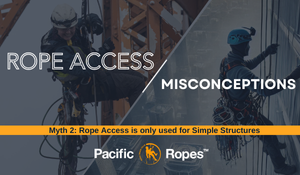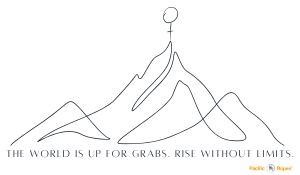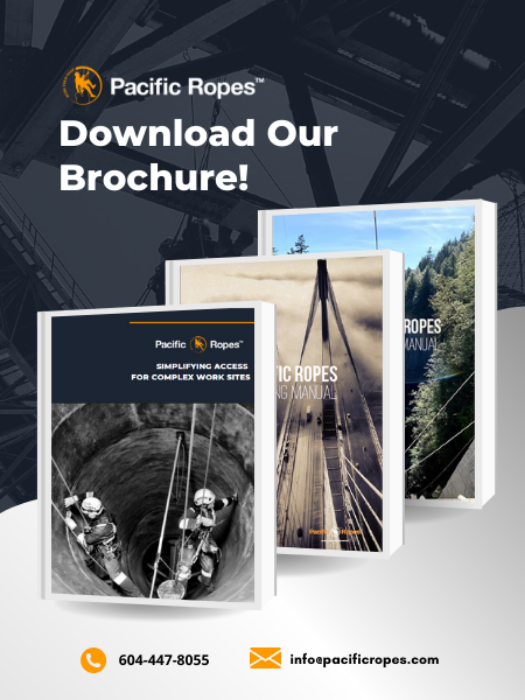**DISCLAIMER: This is not the official WorksafeBC website. The posts below are merely our interpretation and not official WorksafeBC regulation. To make sure you comply, please visit https://www.worksafebc.com/en.
We’re going to cover three sections of the WorkSafe BC regulations related to rope access equipment. Specifically, we’ll be looking at some general equipment safety guidelines, and clarify what you should know about inspection and maintenance, and when a piece of equipment should be retired.
At the bottom of this post, we’ve included a link to a free equipment inspection checklist. You’ll find the download button below. Feel free to use it!
When talking about equipment, we are not just talking about your personal rope access gear kit, but about all the equipment you’ll be engaging with during your work day. This includes anchors and the ropes you’ll be ascending and descending on.
The equipment you use should satisfy some minimum but broad requirements. Let’s break each of those down. We’ll use the wording straight from the WorkSafe BC Regulations, and then expand on what they mean for clarity.
Your rope access equipment must:
- “Consist of components that are compatible and suitable for the intended use”
This means, simply, that it needs to do the job it's been designed to do.
- “[Be] Suitable for the environment in which the equipment is used”
Throughout your career, you’ll be working on a wide variety of structures, including bridges and high rises. You’ll also be working in different weather conditions. Whether or not your equipment is suitable for your environment will depend on the standards they hold. Which brings us to our next point.
- “Meet the requirement of, and be used in accordance with a set of standards.”
A standard is a document that outlines a set of rules and guidelines that have been established and agreed on by a governing body, to ensure the maximum level of order and/or safety of the consumer.
Some of those governing bodies include: CSA (Canadian Standards Association, ANSI (American National Standards Institute), EN (European Norms), NFPA (National Fire Protection Agency), and UIAA (International Climbing and Mountaineering Federation).
We’ve put together a table outlining the standards WorkSafe BC wants each piece of equipment you use to have.
--
A note about responsibility and your personal safety:
Major incidents and fatalities can be avoided through hazard identification, implementing control methods and reassessing the scope of work to ensure a zero-risk site. Generally, a L3 supervising tech is responsible for ensuring/working towards this, but that doesn’t mean if you’re a L1 or L2 tech that this doesn’t concern you. A site’s risk assessment and safety method statement should always be on site and accessible to all team members, and if you ever have any concerns you have the right and responsibility to bring it up.
If you feel as though your safety is not being properly considered, you should always do what you need to in order to feel safe. This may include saying ‘no’ to working or requesting additional or different PPE.
Here’s a story about a rope tech who was not required by his supervisor to wear a helmet, but decided to wear one anyway:
“On this particular day, wearing a helmet saved my life. Despite the lack of consideration for safety precautions on the job sites I worked on, I made the choice to wear a helmet that met the ANSI standard for Industrial Head Protection. I knew the implications of serious head injuries and made a conscious effort to adequately outfit myself for work associated hazards.”
--
Inspection and Maintenance
There are several types of inspections that an item of equipment will be subject to over its’ lifetime. These include acceptance checks, pre-us checks, detailed or thorough checks, and interim inspections.
Prior to getting on the ropes, you’ll also always perform a ‘buddy check’ on another member of your team, and them on you – making sure you have all the equipment you need and everything has been attached correctly (a second set of eyes is always a good thing).
In their regulations, WorkSafe BC specifies that all equipment used in a rope access system needs to be:
- Inspected for defects by you, the user, before beginning your shift (pre-use check).
This isn’t highlighted in their regulations, but where appropriate, it’s also good practice to do a pre-us check after any breaks or periods away from your equipment. - Inspected in the manner and the frequency required by the manufacturer (detailed and thorough checks, and interim inspections)
- The manufacturer specifications are printed and made available on site, in the office, and in the equipment storage area. No piece of equipment can be used outside of these specifications.
- Kept free from substances and conditions that could contribute to the deterioration of the equipment.
Each piece of gear will have its own file listing its inspection history (the date it was inspected, what the results were, and who performed the inspection, etc).
Depending on the equipment type, each of these inspections will be carried out a little differently. The Rope Access Company you’re working for will have a copy of their Rope Access Operating Procedures (RAOP), which will include a detailed overview of all the gear they use, how it should operate, what it should look like, and how to decide if that piece of gear is no longer effective.
For the gear that you’ve purchased for your own personal use, it’d be good practice to have this information on site.
Which brings us to the next section.
Removal from Service
WorkSafe BC clarifies that a piece of rope access equipment must be removed from service if:
- Specified by the manufacturer (in the event of a recall, or the piece of equipment has expired).
- The equipment is defective.
From the time a piece of Rope Access gear is ordered from the supplier, as mentioned above, a file is created for that one single piece of gear. Included in this file, is a specific identification number which helps us to easily connect each piece of gear with its respective documents (such as certificates of conformity, examination, and inspection reports), and helps us to isolate a whole batch of equipment if the need arises (like in the event of a recall).
If a piece of equipment has been removed from service, it can’t be returned until it has been inspected and re-certified by the manufacturer or a professional engineer.
This brings us back full circle to the beginning of this blog. In order for a piece of equipment to be re-certified, it must satisfy those first three points, which again are: that its component parts are compatible and suitable for its intended use, that its suitable to the environments it may be used in, and that it meets the requirements of, and is used in accordance with a set of standards.
That’s all we have to say on this, for now. If you’ve ever trained with us, you know what we set aside a full afternoon for a gear talk, because there’s obviously much more to cover. Another time.
To get a sample copy of a equipment inspection template, fill in the form below!



